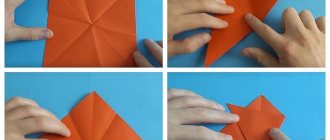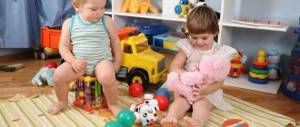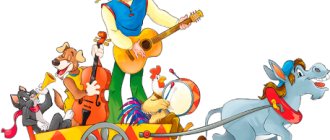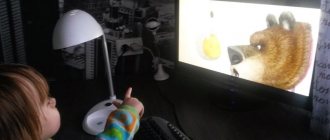How to work with the material?
Our selection of cards is designed to develop children's speech and thinking, familiarize them with the world around them and form initial ideas about professions.
The manual can be used for classes with children from two and a half years old, but it can and should be taught at both 4 and 5 years old. It’s just that activities with a child at different ages are structured differently. So, for a child of two and a half years old it is enough if he knows the name of the profession and can name most of the objects shown in the picture. We already expect from a three-year-old child that he not only knows the names of objects of labor, but can also tell in what profession these objects are used. At 4 years old, a child understands the purpose of most tools and can talk about what a person does in a particular profession.
You can download free pictures of various professions for children. They are suitable for thematic classes, both at home and in early development clubs, in junior schools.
Your child will get to know such professions as: secretary, carpenter, cook, reporter, tour guide, policeman, director, welder, courier, nun, psychic, inspector, dentist, pharmacist, drummer, driver, artist, stylist, district police officer, waiter, nurse, flight attendant, bellhop, pilot, architect, nanny, doctor, singer, guide, cashier, musician, ceramic artist, fireman, hairdresser, photographer, salesman, engineer, veterinarian, teacher, accountant, builder.
Summary of the lesson “Introduction to the profession of a cook”
Cook
, this is a person who prepares food: salads, soups, borscht, pasta, mashed potatoes, fries cutlets, makes dumplings, cooks porridge.
2. Listen to the story of how the profession of a cook
.
— Ancient man did not cook his own food. Everything he found and collected, the man ate raw. This happened because he did not know how to cook food and did not know how to make fire. But even when he learned to make a fire, he used the fire at first only to generate heat or to scare away animals.
Probably some animal was abandoned after hunting near the coals. After some time, the man saw that the meat had darkened, but he liked the taste of it more than raw. So the man guessed that food becomes tastier when cooked.
There were no dishes then, and therefore primitive man cooked food on hot stones around an open fire. Wide leaves of plants replaced his plates; an empty pumpkin, cut in half, served as a cup and at the same time as a saucepan.
Time passed, and man learned to make the first primitive pots and kettles. To do this, they took a basket, coated it with clay and let it dry and harden. Food could be cooked in these pans over a fire, with or without water.
the profession of cook appeared in ancient society.
.
Cook:
What is the name of the special preparation room?
Children: -Kitchen.
Cook:
A modern chef works in a specially equipped kitchen. To prepare dinner, the cook needs assistants. There are items in the kitchen that help the cook prepare food. We will now name these assistants.
3. Didactic game “Who needs what for work”
— Guys, look what interesting instruments we have on the table. Let's try to figure out what tools a chef needs.
Educator: - items that help the cook prepare food. Children: - These are pots, knives, ladles, sieve, spoons, cutting boards and other items
Cook
: Working as a cook requires cleanliness in everything. You should not start cooking in dirty clothes or with unwashed hands. The cook has special clothes. Let's remember what the chef's special clothes are called?
Children:
cap and robe, gloves, apron.
Cook:
Cooking is an art. Many cookbooks are published, containing various recipes for cooking.
Take the children to the recipe
.
Cook:
What is a recipe?
Children:
A set of products and the sequence of cooking.
Demonstration of a cookbook with recipes.
Cook:
How many ways do you think there are to cut potatoes or carrots? Three four? There are more than a dozen such methods. Here are just a few of them: straws, cubes, cubes, circles, slices, shavings, barrels, balls.
What's the best way to tell it?
- For example, let's talk about the profession of a doctor. A doctor is a very necessary profession. The doctor is dressed in a white coat and has a special cap on his head. This is a doctor's form. The doctor treats children and adults from diseases. The doctor works in the hospital. For his work, he needs special tools, such as a phonendoscope, syringe, thermometer, etc. The profession of a doctor is needed in order to protect and treat people from various diseases. With the help of these profession cards in pictures, your child will expand his horizons, learn a lot of new things, develop speech, especially important for 3 years old, and memory. You can download professions in pictures here completely free of charge - click on the image below to download for free:
- A seller, for example, sells goods in a store. This profession requires communication skills and accuracy. The seller must also be able to count well, and the child’s attention should be focused on this.
- An engineer is a complex technical profession that requires good knowledge of mathematics and technology. An engineer can find use in a factory when creating new technical developments.
- A driver is needed everywhere. This is not just a person who drives a taxi. Drivers are required at enterprises, at construction sites, for intercity cargo transportation, etc. This profession requires endurance, attention and, of course, the ability to drive a car.
- A veterinarian treats animals. He must have a medical education. And, of course, the veterinarian must love our little brothers.
- The cook loves to cook, but he does it according to culinary standards and requirements. A cook is needed not only in canteens or restaurants, but also in organizations, schools, and kindergartens.
- The builder participates in the construction of houses. This profession requires physical strength. Construction is a very necessary profession.
- The hairdresser does our hair. A hairdresser must have dexterous hands and a subtle artistic taste.
- An accountant calculates costs and profits at enterprises, firms, and organizations. An accountant must have an economic education and have mathematical abilities.
- A teacher is a rather difficult profession. It is necessary not only to be able to present the material in an interesting way, but also to organize the children’s work. The teacher must have moral restraint and tact, and know his subject well.
How do confectioners work? Journey to the confectionery shop
And now a funny cartoon about the work of confectioners awaits you. You will see how buns are baked in a real factory. You will also learn the story about one famous Russian confectioner and the one who invented raisin buns.
Preschoolers cannot get into a real confectionery shop, so the opportunity to find themselves in one thanks to a video is an opportunity that should not be missed! You must see all this with your own eyes!
The video and cartoon are so interesting and funny that I highly recommend everyone to watch it, even adults - you will learn a lot of new things and get a charge of optimism and a great mood! Enjoy watching!
Tell children about professions
MAGAZINE Preschooler.RF
Project “Who to be? Profession: cook"Developed by teachers of the senior group “Pochemuchki” : Poteryeva Tatyana Aleksandrovna and Arsenyeva Galina Alekseevna. GBOU school No. 1034 October 2020.
Type of project: group, creative, informational, gaming.
Classification: short-term (October)
Composition of participants: group; participants: children, parents, teachers.
Age: 5-6 years
Educational technologies used:
Games and exercises for the development of the emotional sphere
Technology of cognitive development
Using multimedia presentations
Relevance: Every person dreams of finding his favorite thing in life, something that brings joy, pleasure and benefits to people.
Therefore, it is very important to introduce the child to professions and talk about the characteristic qualities that a particular profession requires. The profession of a cook is one of the oldest in the world. In kindergarten and at school, at a factory and in a coal mine, on board an ocean liner and in the vastness of space - everywhere people use the results of the work of cooks. In the work of a cook there is a place for invention, imagination, and ingenuity. How a person is fed affects his mood and health.
Project goals and objectives:
- to form cognitive activity during work
- create conditions for the development of children's creative abilities
- introduce children to the profession of cook, pastry chef
- develop curiosity and interest in this profession
- cultivate respect for work.
- develop in children the ability to use logically constructed statements in speech
- develop the ability to use means of communication with peers and adults in order to obtain the necessary information
- support initiative in the manifestation of creativity.
Ways to solve the tasks
- joint activities of the teacher with children - conversation, observation of the work of the cook, reading fiction, conversations with children, making bakery and confectionery products from plasticine, making drawings.
- joint activities of parents and children - working together in the home kitchen, making croissants.
- direct educational activities on the topic “Profession of a cook” .
Stage-by-stage development of the project “Who should I be? Profession: cook"
1. Selecting a project topic
October
Satisfying the interests and needs of the child and the requests of parents. The initiators are the educators of the group.
2. Planning
Excursion to the d/s kitchen. Conversation with children about the profession of a cook, what objects he uses in his work. Making and baking croissants together with parents.
3. Project implementation
The task of the educator; organizing children's activities in activity centers, equipping the centers with equipment and materials in accordance with the theme of the project:
- search work to select material for the project
- selection of fiction
- selection of appropriate illustrations
- preparing visual aids for modeling
- a selection of riddles about dishes, vegetables and fruits
- excursion to the kindergarten kitchen
- Recommendations for the modern mother in the kitchen (educational games for children)
4. Creation of a developmental environment (equipping activity centers)
- replenish the “kitchen” ; add attributes: aprons, dishes, vegetables, fruits, microwave; organizing a role-playing game: “Family trip to a cafe, restaurant” ; "We invite you to visit" ; "Lunch for dolls" ; "Bakery" , "Bakery store"
- introduce didactic and board games: “Professions” ; “Who has what?” ; "Who's doing what" ; "Wonderful bag" ; “Cook soup and compote” ; "Third wheel"
- replenish your library with books by B. Zakhoder “All works are good” ; V. Mayakovsky “Who to be?” ; K. Chukovsky “Fedorino’s grief” .
- coloring of coloring books “All works are good” , “Fruits and vegetables” , “Dishes”
5. Completion of the project
Creating a Project Presentation
System web of the project “Who should I be? Profession: cook"
Educational area
Direct educational activities
1.
Social and communicative development
Didactic games: “What’s extra” , “Professions” ; “Who has what?” ; “Assemble a picture from cubes” ; "Who's doing what" ; “Wonderful bag” - develop children’s ability to distinguish between the same and different in objects; develop attentiveness and ability to generalize; develop coherent speech
Story-based role-playing game “Dining Room (Cafe)” ; “Preparing borscht” , “Invitation to visit” , “Preparing compote for a doll” , “Setting the table for dinner” - to develop in children interest and respect for the profession of a cook; cultivate an attentive attitude towards visitors and a culture of communication.
2.
Artistic and aesthetic development
Drawing “Portrait of a Chef” ; Modeling from plasticine “Bakery or confectionery product”
Making croissants from dough
Independent activities of children:
looking at paintings, illustrations, coloring coloring books “Vegetables and fruits” , “Dishes” , “All works are good” .
Board and educational games “Professions” , “Vegetables and fruits” , “Who has what” , “Assemble a picture from cubes” , “Who does what?” , "Wonderful bag" .
Dramatization based on the poem by S. Mikhalkov “Vegetables” , “Cooking Porridge”
3.
Speech development
Verbal game “Cooking compote” - developing attention, intensifying the use of adjectives, expanding the vocabulary.
Compilation of stories “How your mother cooks”
Reading poems and riddles about the cook B. Zakhoder;
Learning the poem “We are the cooks”
D/exercise “Think, with the help of what helper items can you prepare mashed potatoes?” etc
Reading fiction: B. Zakhoder “All works are good” ; V. Mayakovsky “Who to be?” ; K. Chukovsky “Fedorino’s grief” - to maintain and consolidate interest in fiction as a means of obtaining new information.
Guessing riddles about dishes, vegetables and fruits.
4.
Cognitive development
Didactic game “Waiting for Guests” - developing attention, consolidating the names of dishes, expanding the vocabulary.
Conversation with children about the profession of a cook;
Excursion to the kitchen - the profession of a cook, familiarization with his work processes; develop curiosity.
D/ and “Cook's Assistants” - practice naming objects for the cook.
D/i “Dishes” - consolidate knowledge about tableware.
Literature:
B. Zakhoder “All works are good” , V. Mayakovsky “Who to be” , K. Chukovsky “Fedorino’s grief” , S. Mikhalkov “Vegetables” .
Methodological literature: Gerbova, Maksakova. Didactic games.
S. Chertkov - Children about professions.
| Next > |









